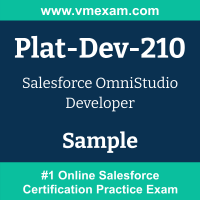 We have prepared Salesforce OmniStudio Developer (Plat-Dev-210) certification sample questions to make you aware of actual exam properties. This sample question set provides you with information about the OmniStudio Developer exam pattern, question formate, a difficulty level of questions and time required to answer each question. To get familiar with Salesforce Certified OmniStudio Developer exam, we suggest you try our Sample Salesforce Plat-Dev-210 Certification Practice Exam in simulated Salesforce certification exam environment.
We have prepared Salesforce OmniStudio Developer (Plat-Dev-210) certification sample questions to make you aware of actual exam properties. This sample question set provides you with information about the OmniStudio Developer exam pattern, question formate, a difficulty level of questions and time required to answer each question. To get familiar with Salesforce Certified OmniStudio Developer exam, we suggest you try our Sample Salesforce Plat-Dev-210 Certification Practice Exam in simulated Salesforce certification exam environment.
To test your knowledge and understanding of concepts with real-time scenario based Salesforce Plat-Dev-210 questions, we strongly recommend you to prepare and practice with Premium Salesforce OmniStudio Developer Certification Practice Exam. The premium Salesforce OmniStudio Developer certification practice exam helps you identify topics in which you are well prepared and topics in which you may need further training to achieving great score in actual Salesforce Certified OmniStudio Developer exam.
Salesforce Plat-Dev-210 Sample Questions:
01. Before deploying an OmniStudio solution, what is an essential step to ensure its reliability across different Salesforce orgs?
a) Hardcoding all API URLs and credentials
b) Performing thorough testing in a sandbox environment
c) Skipping security review for faster deployment
d) Using the highest data visibility settings for all components
02. In Expression Sets, what allows for the dynamic evaluation of input data to apply business logic?
a) Hard-coded values specific to each Salesforce org
b) External JavaScript libraries imported into Salesforce
c) Variable placeholders that represent input data or constants
d) Direct integration with Salesforce Einstein for AI-based decision making
03. What feature distinguishes a DataRaptor Load action?
a) It is designed to create or update records in Salesforce.
b) It extracts data from Salesforce objects without saving changes.
c) It generates reports based on Salesforce data.
d) It sends email notifications based on data conditions.
04. When encountering errors during the deployment of OmniStudio components, which Salesforce tool can provide detailed error logs?
a) Salesforce Optimizer
b) Setup Audit Trail
c) Deployment Status in Setup
d) Salesforce Health Checker
05. Which of the following is an example of how Decision Matrices could be applied?
a) To automatically assign leads to sales reps based on geographical location
b) To design the layout of a FlexCard
c) To schedule batch jobs for data processing
d) To develop custom Salesforce Lightning components
06. How can DataRaptors be optimized to handle large volumes of data efficiently?
a) By increasing the batch size in the DataRaptor settings
b) By splitting large datasets into multiple DataRaptors
c) Through the use of efficient data mappings and minimizing unnecessary data transformations
d) By converting the DataRaptor into an Apex class for improved performance
07. When would you use a Calculation Procedure in OmniStudio?
a) To define business logic that calculates values based on input data.
b) To create complex user interfaces.
c) To schedule recurring data integration tasks.
d) To manage user access and permissions.
08. What advantage do Decision Matrices offer when dealing with complex business rules?
a) They can directly interact with the Salesforce database
b) They simplify the management of complex conditional logic without writing code
c) They offer a graphical interface for database administration
d) They automatically enforce Salesforce security protocols
09. Which of the following OmniStudio tools can be called from an OmniScript to perform complex data operations?
a) Lightning Web Components
b) DataRaptors
c) Apex Classes
d) Integration Procedures
10. What is a critical consideration when designing Integration Procedures for real-time data synchronization?
a) Ensuring that all data mappings are hard-coded for speed.
b) Designing the procedure to handle high volumes of data efficiently and minimize API callouts.
c) Limiting the procedure to interact with only one external system at a time.
d) Using only synchronous calls to ensure data consistency.
Answers:
Question: 01
Answer: b |
Question: 02
Answer: c |
Question: 03
Answer: a |
Question: 04
Answer: c |
Question: 05
Answer: a |
Question: 06
Answer: c |
Question: 07
Answer: a |
Question: 08
Answer: b |
Question: 09
Answer: d |
Question: 10
Answer: b |
Note: Please update us by writing an email on feedback@vmexam.com for any error in Salesforce Certified OmniStudio Developer certification exam sample questions
 We have prepared Salesforce OmniStudio Developer (Plat-Dev-210) certification sample questions to make you aware of actual exam properties. This sample question set provides you with information about the OmniStudio Developer exam pattern, question formate, a difficulty level of questions and time required to answer each question. To get familiar with Salesforce Certified OmniStudio Developer exam, we suggest you try our Sample Salesforce Plat-Dev-210 Certification Practice Exam in simulated Salesforce certification exam environment.
We have prepared Salesforce OmniStudio Developer (Plat-Dev-210) certification sample questions to make you aware of actual exam properties. This sample question set provides you with information about the OmniStudio Developer exam pattern, question formate, a difficulty level of questions and time required to answer each question. To get familiar with Salesforce Certified OmniStudio Developer exam, we suggest you try our Sample Salesforce Plat-Dev-210 Certification Practice Exam in simulated Salesforce certification exam environment.